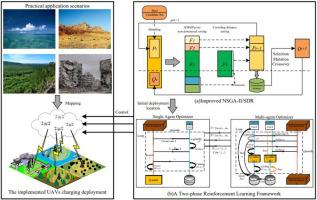联合强化学习优化多个无人机充电器部署,以满足物联网中单个能源需求
IF 9.6
Q1 COMPUTER SCIENCE, ARTIFICIAL INTELLIGENCE
引用次数: 0
摘要
利用无人机(uav)的无线电力传输(WPT)技术为提高无线传感器网络(wsn)的使用寿命提供了新的途径,无线传感器网络是物联网(IoT)的关键组成部分。然而,现有的充电部署研究往往忽略了网络内部的异构能量需求,导致高能耗节点的充电效率较低。针对多无人机最优协同充电部署问题(muav - occdp),提出了一种阶段性优化策略。首先,构建网络拓扑,记录节点能量需求;基于力量优势关系(SDR),设计了一种改进的NSGA-II算法生成初始部署方案。然后,建立了两阶段强化学习框架:第一阶段通过优化覆盖节点数和平均充电效率来减少无人机数量;第二阶段通过多智能体经验共享和混合奖励机制促进协作,实现充电能量均衡分配。本文章由计算机程序翻译,如有差异,请以英文原文为准。

Joint reinforcement learning to optimize multiple UAV charger deployments for individual energy requirement in IoT
The technology of wireless power transfer (WPT) utilizing unmanned aerial vehicles (UAVs) presents novel avenues for enhancing the longevity of wireless sensor networks (WSNs), which constitute a critical component of the Internet of Things (IoT). However, existing research on charging deployment generally overlooks the heterogeneous energy requirements within the network, resulting in low charging efficiency for high-energy-consuming nodes. This paper addresses the multiple UAVs optimal cooperative charging deployment problem (MUAVs-OCCDP) and proposes a phased optimization strategy. Firstly, it constructs the network topology and records the energy requirements of the nodes. Based on the strength advantage relationship (SDR), an improved NSGA-II algorithm is designed to generate the initial deployment plan. Then, a two-phase reinforcement learning framework is established: the phase 1 aims to reduce the number of UAVs by optimizing the number of covered nodes and the average charging efficiency; the phase 2 promotes collaboration through the sharing of multi-agent experience and a hybrid reward mechanism to achieve balanced charging energy distribution.
求助全文
通过发布文献求助,成功后即可免费获取论文全文。
去求助
来源期刊

Energy and AI
Engineering-Engineering (miscellaneous)
CiteScore
16.50
自引率
0.00%
发文量
64
审稿时长
56 days
 求助内容:
求助内容: 应助结果提醒方式:
应助结果提醒方式:


